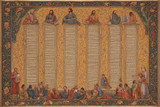Little Bible Translation History for Hungarians / The first Hungarian Bible translation that we know of today was left to us only in pieces and was written around 1430-1450AD
The translation of Bálint Ujlaki and Tamás Pécsi Parts of the Old Testament (Vienna-codex)
The four gospels (Munich-codex)
The first Hungarian Bible translation that we know of today was left to us only in pieces
and was written around 1430-1450AD, in the southern part of Hungary, in the well-developed district of Smyrna, in the town of Kamenica, close to Petrovaradin, on the
The Danube. It was written by two priests who studied at the University of Prague: Bálint
Ujlaki and Tamás Pécsi. They fell under suspicion of heresy, so they fled with a little
body of their disciples to the eastern slopes of the Carpathian Mountains in Moldova and
settled there. This is where the valued manuscripts, the four gospels were copied by the
Csango Hungarians. The Vienna-codex which contains parts of the Old Testament was
finished around the 1540s, but we do not know the place or the circumstances of it. The
language of the translation, which was also called the Hussite Bible, due to the studies of
its translators in Prague and their heresy (?) is the Hungarian of the age of János Hunyadi.
Balázs Szalkai Magyar, a Franciscan monk reported of the work of Bálint Ujlaki and
Tamás Pécsi. In the middle of the 1400s, he put down the history of his convent in
Hungary and Bosnia. There we read the following:
“At this time two educated people also left Kamenica, Tamás and Bálint, who after
consulting with some compulsive men and women, fled to Moldavia in the middle of the
night […] THESE TWO PRIESTS TRANSLATED WRITINGS OF BOTH TESTAMENTS INTO THE
HUNGARIAN LANGUAGE.” (The revolution of the Hungarian middle ages, by Sándor V.
Kovács in Budapest, 1984. Translation by Ferenc Csonka)
So far it was not possible to find out, whether they translated the entire Old Testament,
but only some parts survived or only some important passages, necessary for the practices
of their religious life (and for the masses).
Today we only know the following parts of the Vienna-codex: the books of Ruth, Judith
and Esther, some passages of the second book of the Maccabees, and the prophets, almost
wholly.
It is remarkable, that important parts of the Old Testament, that are often read during the
masses are missing, for example, prophecies of Isaiah and Jeremiah, which are so significant
for Advent and Lent, not to mention the first book of Moses, the history of creation. No
native preacher could get on without these, while the most important task of the
Franciscans were preaching in native languages and pastoral care – it was no coincidence
that the first Hungarian Scripture translation was written by Franciscan monks.
Why is the text of the Vienna-codex missing some parts then?
We only learned about the existence of this codex in 1799 (István Sándor: A WIDE RANGE
VI); first published by Gábor Döbrentei in 1838. But Péter Pázmány saw Hungarian
Bibles in the 15
th
century. “I HAVE SEEN DIFFERENT HUNGARIAN AND GERMAN NEW
TESTAMENTS AND BOOKS OF THE OLD TESTAMENT, THAT WERE TRANSLATED BEFORE
THE BIRTH OF LUTHER [that is before 1843!].” (SERMONS, Bratislava, 1636)
If the Vienna-codex happened to contain only some chosen passages, it would be
remarkable that the translators omitted important passages while they paid so much
attention to the great women of the Bible: Ruth, Esther, and Judith…
- Ruth: the great-grandmother of David, who is mentioned in the gospel of Matthew for
that, who returns to Bethlehem after the death of her father, who was born in Bethlehem,
“IN THE BEGINNING OF BARLEY HARVEST”. Ruth got to know her husband as she
“GLEANED IN THE FIELD AFTER THE REAPERS”. This is the first and only OT mention of
the greeting that is rhythmically repeated during the liturgy of the masses: “THE LORD BE
WITH YOU.” The exact words of this phrase in the Vienna-codex were repeated in Gáspár
Heltai’s translation in 1565.
Next to the modest, diligent “housewife”, Ruth the Moabitess from Bethlehem, there are
Judith, the bold and dynamic woman, who is ready to fight for her country, and Esther,
who is born to be a queen, to whom the king is willing to give half of his kingdom?
We have chosen two passages, one from the Book of Esther, and the other from the Book of
Jonah, because the first contains instructive moments of the history of civilization – of
architecture and social customs – and of the development of fiction, and because the
second is one of the fundamentals of developing narrative poetry.
- Ujlaki Bálint és Pécsi Tamás fordítása
Részletek az Ószövetségből (Bécsi-kódex)
A négy evangélium (Müncheni-kódex)
Az első, általunk ma ismert, bár csupán töredékesen ránk maradt magyar nyelvű Biblia-
fordítás az 1430-1450-es években keletkezett. A dél-magyarországi Szerémség akkor
igen fejlett vidékén, a Pétervárad melletti, Duna parti Kamenica községben készült; két
prágai egyetemet járt pap: Ujlaki Bálint és Pécsi Tamás műve. 1439-ben eretnekség
gyanújába kerültek, s ezért híveikkel együtt a Kárpátok keleti lejtőire, a Moldovába
menekültek-települtek. Itt másolták le a becses kéziratot, pontosan: a négy evangéliumot,
csángó magyarok. Az Ószövetség egyes részeit tartalmazó Bécsi-kódexet az 1540-es
évek táján tisztázták le, nem tudjuk, hol és milyen körülmények között. A fordítók prágai
tanulmányai és eretnekségük (?) miatt Huszita Bibliának is nevezett mű nyelve tehát
Hunyadi János korának magyarsága.
Ujlaki Bálint és Pécsi Tamás működéséről Szalkai Magyar Balázs Ferenc-rendi szerzetes
tudósít. Az 1400-as évek közepe táján megírta rendjének magyarországi és boszniai
történetét. Ebben olvasható:
„Ebben az időben még két tanult ember is távozott innen Kamenicáról, tudniillik Tamás
és Bálint, akik, miután ezt néhány megszállott férfival és asszonnyal megtanácskozták,
éjnek idején Moldvába szöktek […] EZ A KÉT PAP MINDKÉT TESTAMENTUM ÍRÁSAIT
LEFORDÍTOTTAMAGYARNYELVRE.” (A MAGYARKÖZÉPKORFORRADALMA V. Kovács
Sándor gondozásában. Bp. 1984. Csonka Ferenc fordítása)
Egyelőre kideríthetetlen, hogy az egész Ószövetséget lefordították-e, és csupán a sors
szeszélyéből maradt ránk mindössze néhány részlet, vagy pedig talán csak a számukra
legfontosabb helyeket magyarították, a vallásos élet (miserend) gyakorlati igényeihez
alkalmazkodva.
Mi ma a Bécsi-kódexből a következő részeket ismerjük: Rut könyve, Judit könyve, Eszter
könyve, a Makkabeusok második könyvéből néhány részlet; valamint a próféták,
csaknem teljesen.
Feltűnő, hogy a mise olvasmányok fontos ószövetségi helyei hiányoznak, például Izajás,
Jeremiás prófétáknak az ádventi és nagyböjti időszakban oly jelentős jövendölései; nem
is szólva Mózes első könyvéről, a teremtéstörténetről. Ezek nélkül egyetlen anyanyelvű
igehirdető sem boldogulhatott, márpedig a ferences rendnek éppen az anyanyelvű
igehirdetés és lelkigondozás volt az egyik legfontosabb feladata – nem is véletlen tehát,
hogy az első magyar nyelvű Szentírás-fordítás ferences papok tollából származik.
De akkor miért töredékes a Bécsi-kódex anyaga?
E kódex létezéséről csak 1799 óta tudunk (Sándor István: SOKFÉLE VI); Döbrentei Gábor
adta először közre nyomtatásban, 1838-ban. Viszont Pázmány Péter még látott 15.
századi magyar Bibliákat: „LÁTTAM NEM EGYFÉLE MAGYAR ÉS NÉMET
ÚJTESTAMENTUMOT ÉS ÓTESTAMENTUMNAK SOK KÖNYVEIT, MELYEKET LUTHER
SZÜLETÉSEELŐTT [vagyis 1843 előtt!] FORDÍTOTTAK.” (PRÉDIKÁCIÓK Pozsony 1636)
Ha netán ez a Bécsi-kódex eredetileg is szemelvényes jellegű fordítás volt, akkor feltűnő,
hogy miközben a fordítók fontos részleteket mellőznek, nagy figyelmet szentelnek a
bibliai asszonyhősöknek: Rutnak, Eszternek, Juditnak...
- Rut: Dávid dédanyja, aki ezért Máté evangéliumában is megemlíttetik és aki betlehemi
származású atyjának halála után, „MIDŐN AZ ÁRPÁK ELŐSZER ARATTATNAK VALA”,
visszatért Betlehembe. Rut kalászszedés közben – „SZED VALA GABONAFŐKET AZ
ARATÓKHÁTAMEGETT” – ismerkedik meg férjével. Itt hangzik el, a Bibliában először és
az Ószövetségben egyetlen alkalommal a mise szövegében ritmikusan visszatérő
köszöntés: „AZ ÚR LEGYEN VELETEK.” A Bécsi-kódexben: „ÚR TÜVÉLETEK.” (Ugyanígy
olvasható Heltai Gáspár 1565-os fordításában is!)
A szerény, szorgalmas, „háziasszony” betlehemi moabita Rut mellett Judit a hazájáért
harcolni kész, bátor és tetterős asszony, Eszter pedig uralkodásra termett nő, akivel a
király fele országát is hajlandó megosztani.
Mivel Eszter könyve mind művelődéstörténetileg – építkezési, társaséleti szokások –,
mind a széppróza fejlődése szempontjából tanulságos mozzanatokat tartalmaz, és mivel a
Jónás könyve szintén egyik alapeleme a kialakulófélben levő elbeszélő költészetnek: e
kettőből választottunk ki egy-egy részletet.
Explore Popular Articles
A Tapestry of Scriptures: Discovering Diverse Bibles from Around the World
A Tapestry of Scriptures: Discovering Diverse Bibles from Around the WorldIn a quiet corner of the...
A Tapestry of Devotion - Diverse Bibles for a Global Congregation
A Tapestry of Devotion - Diverse Bibles for a Global CongregationIn a world rich with cultural and l...
Unveiling the Sacred: A Literary Journey Through BIML's Hungarian Bibles
Unveiling the Sacred: A Literary Journey Through BIML's Hungarian BiblesIn the vast mosaic of langua...
An Ode to the Sacred Texts: A Multilingual Journey Through the Bible's Many Tongues
An Ode to the Sacred Texts: A Multilingual Journey Through the Bible's Many TonguesIn the great tape...
Exploring Scripture Across Cultures: The Beauty of Multilingual Bibles
Exploring Scripture Across Cultures: The Beauty of Multilingual BiblesIn a world brimming with a m...
The Profound Resonance of Multilingual Bibles: A Tapestry of Faith Across Languages
The Profound Resonance of Multilingual Bibles: A Tapestry of Faith Across LanguagesIn the intricate...







